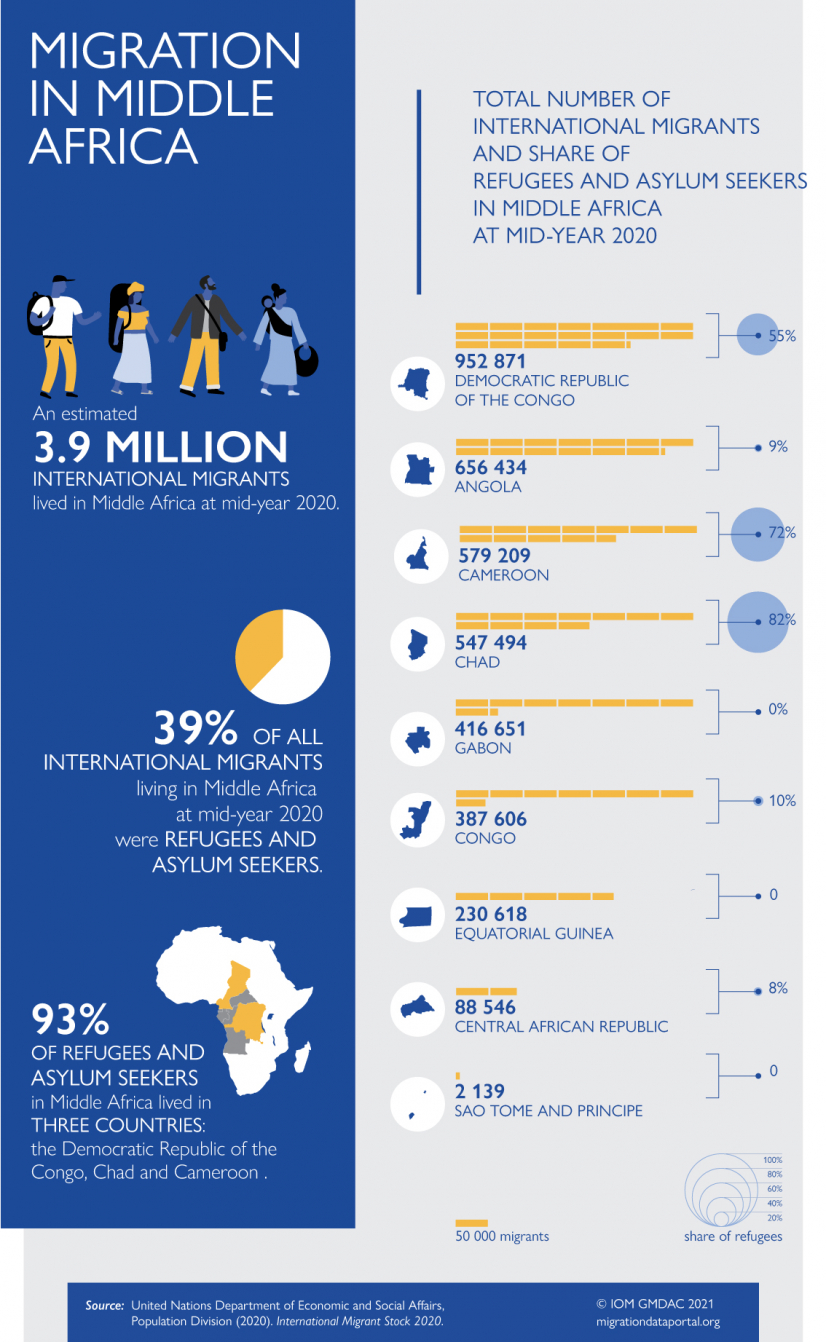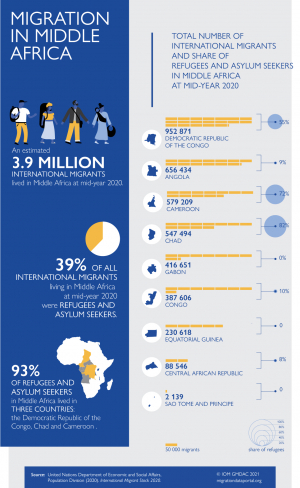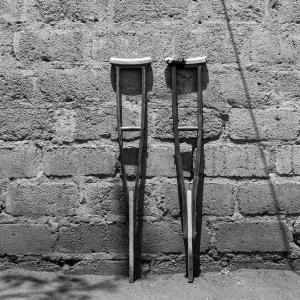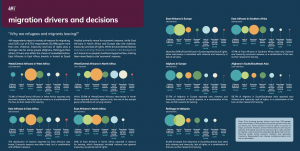
Migration data in Middle Africa
The nine countries that make up Middle Africa1– Angola, Cameroon, the Central African Republic, Chad, the Republic of Congo, the Democratic Republic of the Congo, Equatorial Guinea, Gabon and Sao Tomé and Principe – have not traditionally formed a highly integrated region. Many countries have stronger ties outside the region, in part due to low levels of intra-regional trade and limited transportation infrastructure, resulting in relatively low rates of intra-regional migration (Byiers, 2017, Bazonzi, 2014). However, a large majority of migrants still move within Africa — nearly 75 per cent of all migrants from Middle Africa resided in another African country as of mid-year 2020 (UN DESA, 2020). Recurrent conflict and instability also drive substantial forced migration, and nearly 39 per cent of all migrants in the sub-region were refugees and asylum seekers as of mid-2020 (UN DESA, 2020). Despite the existence of formal free movement commitments in the region since 1983, substantial barriers continue to hamper greater cooperation on migration policy.
Recent trends
COVID-19
Mobility in Middle Africa has been greatly impacted by COVID-19. All countries in the region closed borders and some restricted internal movement. By November 2020, air borders had largely reopened, but many land borders remain closed; Angola and Cameroon continued to impose entry restrictions on most foreign nationals and, Gabon limited entry to European Union citizens, and other countries in the sub-region required medical certificates or screening (IOM, 2020a). As of March 2021, one year after the first case of COVID-19 in the region, partially opened and fully opened Points of Entry (PoEs) accounted for 54 per cent (as compared with 37% in June 2020). Air and land borders have largely reopened. Cameroon, Gabon and the Republic of Congo continue to impose entry restrictions on most foreign nationals. Many other countries in the sub-region require medical certificates or screening. COVID-19 also impacted census activities, in the three countries where censuses were originally scheduled to take place in 2020—Cameroon, Republic of Congo and the Democratic Republic of the Congo.
Host countries
An estimated 3.9 million international migrants resided in Middle Africa at mid-year 2020, making up 2.2 per cent of the total population. In absolute numbers, the Democratic Republic of the Congo (952,871) and Angola (656,434) hosted the most migrants, while Gabon (18.7%) and Equatorial Guinea (16.4%), countries with significant natural resource reserves, hosted the largest shares of migrants in their respective populations (UN DESA, 2020).
Destination countries
Almost 75 per cent of migrants from Middle Africa move to other African countries, but only 36 per cent of all migrants from Middle Africa stay within the sub-region. As of mid-year 2020, 28 per cent lived in Eastern Africa and 20 per cent in Europe. Although the share of migrants in Europe has not changed significantly in recent years, migration to Northern America grew significantly, from less that 1 per cent in 1990 to 4 per cent by 2020 (UN DESA, 2020).
Forced displacement
Middle Africa is both an origin and host sub-region for large numbers of refugees and asylum seekers. Almost 1.5 million refugees and asylum seekers were estimated to be in the sub-region at mid-year 2020, making up 39 per cent of all migrants (UN DESA, 2020). 93 per cent of these refugees and asylum seekers were hosted in three countries: the Democratic Republic of the Congo, Chad and Cameroon (ibid.). Over 90 per cent of the 1.5 million refugees originally from Middle Africa at the end of 2019 came from the Democratic Republic of the Congo or the Central African Republic, both of which were among the top 10 countries of origin for refugees globally (UNHCR, 2020).
Middle Africa also accounted for two of the top 15 countries in terms of internally displaced people (IDPs) at the end of 2020. As of 31 December 2020, the Democratic Republic of the Congo alone had nearly 5.3 million people internally displaced due to conflict and violence, trailing only the Syrian Arab Republic globally (IDMC, 2021). As of October 2020, over 1 million people were internally displaced in Cameroon due to crises in the Lake Chad Basin area and the North-West South-West regions and 401,511 people were internally displaced in Chad (IOM, 2021; UNOCHA, 2020).
Internal migration
Many more people migrate internally than internationally, driven by movement from rural areas to urban centers. Urbanization rates have been higher in Middle Africa than in most other parts of Sub-Saharan Africa since the colonial era and have continued to grow, reaching 50 per cent in 2018, compared to 28 per cent in Eastern Africa and 46 per cent in Western Africa (UN DESA, 2018).
Remittances
Remittances account for a very small share of GDP in most Middle African countries for which data are available. However, in absolute terms, the Democratic Republic of the Congo is the highest recipient of remittances in the sub-region and among the top five recipients in sub-Saharan Africa. It received 84 per cent of the 2.3 billion USD received in the sub-region in 2020, accounting for 3.9 per cent of its GDP. Estimates for 2020 available as of May 2021 show that remittances to the sub-region dropped by nearly 6.6 per cent compared to 2019 (World Bank, 2021).
Deportation of migrants
Forced expulsions of migrants have continued to occur in the sub-region, most notably in Angola. Over 400,000 migrants from the Democratic Republic of the Congo were forcibly expelled or fled Angola in October 2018 (Human Rights Watch, 2018). Since 2020, nearly 13,000 Congolese returned from Angola to the Kasaï-Central Province (IOM, 2021) and more than 21,000 had been expelled to the Kasaï Province (ECHO, 2020).
Past and present trends in migration
Early history through the colonial period
Starting in the 3rd millennium BCE, Bantu-speaking people from modern Cameroon and Nigeria migrated south and east, eventually settling in much of the southern half of Africa, including most of Middle Africa (Ehret, 2015).
Portuguese traders first reached Middle Africa in the 15th century, establishing trading posts along the west coast and initiating the transatlantic slave trade. Over half of the millions of people forcibly transported to the Americas between the 16th and 19th centuries left from ports in Middle Africa, including almost 3 million people from a single port in Luanda, Angola (Lovejoy, 2011).
Migration within the region accelerated during the later colonial period, as new settlements and urban expansion drove increasing demand for both voluntary and forced labour (Lututala, 2007; Flahaux and Schoumaker, 2016). Although most labour migrants came from nearby areas, low population density in much of the region and high labour costs meant that migrants were at times recruited from farther away (Lututala, 2007). In coastal areas along the Gulf of Guinea, labour migrants were recruited from Western Africa following pre-colonial mobility patterns (Bazonzi, 2014). In then Belgian Congo (Democratic Republic of the Congo), migration was managed by state authorities, who brought thousands of labourers from Rwanda and Burundi to work for colonial mining companies, plantations and industry (Bazonzi, 2014).
Post-independence
Increasing numbers of European migrants had moved to Middle Africa after World War II, particularly to then Belgian Congo and Angola, but most left following independence (Flahaux and Schoumaker, 2016). At the same time, labour migration to the region continued. Starting in the 1950s, oil production in countries along the Gulf of Guinea, as well as strong resource exports in the Democratic Republic of the Congo, contributed to economic growth and migration (OECD, 2004), and Gabon and Equatorial Guinea enacted formal policies to encourage labour migration (Bazonzi, 2014). However, a collapse in commodity prices in the 1980s led to economic deterioration. In 1986, Gabon ended its labour recruitment policies in order to promote greater “Gabonization” of employment. Migrants were victims of xenophobic violence and expelled from several countries in the region during the 1980s and 1990s (Lututala, 2007).
Conflict and civil war also caused significant displacement in Middle Africa during this period. Angola’s war for independence (1960-1974) and the decades-long civil war that followed led to the internal displacement of more than four million people and almost 500,000 refugees, most moving to the Democratic Republic of the Congo (Council on Foreign Relations, 2002). Large numbers of refugees also left Chad for neighboring countries due to civil war in the 1980s (UNHCR, 2020).
The Democratic Republic of the Congo (known as Zaire between 1971 and 1997) experienced large-scale conflict and displacement multiple times since independence. Successive secessionist attempts in resource-rich southern areas caused widespread displacement starting in the 1960s, and ethnic conflict between agrarian communities and migrants from Rwanda, who had migrated during several waves since the 1880s, occurred repeatedly in the east (Lututala, 2007; Flahaux and Schoumaker, 2016). In 1994, over 1.2 million Rwandan refugees, fleeing both genocide and later retaliation by the Rwandan Patriotic Front, arrived in eastern Zaire (Murison, 2002). When Rwanda invaded in 1996 to defeat rebel groups operating from Zaire, opposing Zairean factions joined the fighting, launching the First Congo Civil War (Flahaux and Schoumaker, 2016). The Second Congo Civil War, from 1998-2003, resulted in more than 400,000 Congolese refugees in neighbouring countries, millions of people internally displaced and the return of hundreds of thousands of Rwandan refugees (UNHCR, 2007).
Present day
Migration rates and destinations for migrants from Middle Africa have remained largely stable in recent years. The share of migrants from Middle Africa who stay in the sub-region, at 35 per cent, is lower than the share who stay in other African sub-regions, except Northern Africa. Most migrants from the Democratic Republic of the Congo, Chad and the Central African Republic go to African countries, while former colonial powers are the top destination countries for migrants from Angola, Cameroon, Republic of Congo, Gabon and Sao Tomé and Principe. Migration to South Africa has also grown from Angola, Republic of Congo, and the Democratic Republic of the Congo in recent decades (UN DESA, 2020).
Top origin countries for international migrants residing in Middle Africa depend heavily on conflict patterns. At mid-year 2020, the largest share of migrants in the sub-region came from the Central African Republic (20%), Sudan (10%), the Democratic Republic of the Congo (8%), Rwanda (7%), Angola (6%), and Nigeria (5%), and these migrants primarily moved to neighbouring countries. These countries have dominated the list of top origin countries in Middle Africa for decades, with the relative percentages varying based on displacement trends (ibid.).
Forced Migration: Cameroon, Chad, the Democratic Republic of the Congo and the Central African Republic account for most forced displacement in the sub-region:
- Cameroon: Multiple crises have contributed to displacement in Cameroon in recent years. Attacks by Boko Haram and a changing climate have led to large-scale displacement in the north, with over 321,000 IDPs and 114,000 refugees recorded as of October 2020 (IOM, 2020b). Conflict between non-state armed groups and government security forces in the English-speaking North-West South-West areas have resulted in a further 705,800 IDPs within or displaced from the region and 60,900 Cameroonian refugees in Nigeria (UNOCHA, 2020). Almost 293,000 refugees from the Central African Republic also resided in Cameroon as of the end of 2019 (UNHCR, 2020).
- Democratic Republic of the Congo: Almost 2.2 million people were newly displaced within the Democratic Republic of the Congo in 2020 due to armed conflict and intercommunal fighting in the east and 279,000 people were newly displaced due to disasters (IDMC, 2021). An additional 800,000 Congolese refugees are currently displaced, the majority residing in neighbouring countries (UNHCR, 2020).
- Central African Republic: A quarter of the population has been displaced since conflict escalated in 2013. New displacement continues, with refugee numbers reaching a peak of over 600,000 people in 2019 and almost 100,000 people newly internally displaced (IDMC, 2020; UNHCR, 2020; NRC, 2020).
- Chad: 294,671 people were internally displaced in Chad as of October 2020 due to the crisis in the Lake Chad Basin (IOM, 2020b). More than 442,000 refugees were also living in Chad at the end of 2019, 97 per cent from Sudan or the Central African Republic (UNHCR, 2020).
Data sources
No sources of data on migration focus specifically on Middle Africa alone. The most common sources of comparable data come from international organizations. However, data are not always available for all countries in the sub-region.
Regional and international data sources:
- UN Department of Economic and Social Affairs (UN DESA) produces regular estimates of international migrant stocks disaggregated by age, sex, origin and destination.
- IOM collects a variety of data on migrant and IDP populations through the Displacement Tracking Matrix (DTM), including information on stocks, flows, profiles, vulnerabilities and living conditions. Some datasets are open, while other data are provided through dashboards and reports. DTM is currently operating in Cameroon, Central African Republic, Chad and the Democratic Republic of the Congo. IOM also publishes regular reports with data on migrants who were aided by its assisted voluntary return and reintegration (AVRR) programs, including information on host and origin countries, sex, age and vulnerabilities.
- The International Labour Organization’s data portal, ILOSTAT, includes multiple country-level indicators on labour migration and occupational injuries disaggregated by migration status.
- UNHCR manages the Refugee Population Statistics Database, which includes data on refugees, asylum seekers, IDPs and other populations of interest, reported by country of origin and country of asylum. Dashboards for specific countries in Middle Africa can be found at the UNHCR Operations Portal.
- International Displacement Monitoring Centre (IDMC) publishes data on internal displacement stocks and new displacement from conflict and disaster through its Global Internal Displacement Database.
- The Counter Trafficking Data Collaborative (CTDC) publishes anonymized data on identified cases of human trafficking contributed by counter trafficking organizations.
- The World Bank produces data on remittance inflows and outflows.
- Afrobarometer published data on emigration plans and reasons for emigration in Cameroon, Gabon and Sao Tomé and Principe from its public attitude surveys (2016-2018).
- The African Union has released two reports on labour migration statistics in Africa, with estimates on the number of migrant workers in the Economic Community of Central African States (ECCAS).
Censuses and household survey data:
- Population and Housing Censuses: Only six of the nine countries in Middle Africa conducted censuses during the 2010 census round. Census questionnaires for most countries are available from the United Nations Statistics Division, and reports and some data, including information on migration, are available through individual countries’ national statistics offices.
- Labour Force Surveys: Based on data provided by the ILO, fewer than half of the countries in Middle Africa have carried out labour force surveys. The ILO provides a list of questionnaires and reports by country.
- Demographic and Health Surveys (DHS): All countries in Middle Africa have conducted DHS surveys, most in the last 10 years. Datasets and reports are available online, although limited information on migration is included.
Other sources of data and analysis:
- UN OCHA manages the Humanitarian Data Exchange (HDX), an open data platform for sharing humanitarian data. Many intergovernmental, governmental and civil society organizations working in Middle Africa upload datasets to this platform.
- REACH publishes granular data and analysis in crisis areas through its Resource Centre. They currently work in the Central African Republic and the Democratic Republic of the Congo and previously worked in Chad, Cameroon and Republic of Congo.
- ACAPS produces data-based reports and analysis on humanitarian issues in Chad, Cameroon, Republic of Congo, Central African Republic and the Democratic Republic of the Congo.
Strengths and limitations of the data sources
Reliable regional-level data on migration in Middle Africa are very limited. Most nationally representative data come from censuses and household surveys; however, three of the nine countries in the region did not conduct a census during the 2010 census round, and the Democratic Republic of the Congo has not completed a national census since 1984. Few nationally representative surveys are regularly conducted. While all countries in the region have completed DHS surveys, these provide little or no information on migration, and labour force surveys have been carried out in fewer than half the countries in Middle Africa. Specialized national surveys on migration are close to nonexistent in the region, and in practice most data on migration come from small-scale, local surveys that are not representative (Ngoie Tshibambe, 2014a). Administrative data are collected through police and border authorities but are difficult to access by researchers and are not designed for statistical purposes (ibid).
No regional structure is charged with carrying out data collection on migration or promoting harmonization of data among countries in Middle Africa, limiting the quality and comparability of migration data (Lututala, 2007; Ngoie Tshibambe, 2014a). Existing data are fragmented, use multiple, inconsistent reference periods and lack consistent definitions (Ngoie Tshibambe, 2014a).
UN DESA estimates are the most commonly used source of comparable migration data for countries in Middle Africa, but since they are projections based on census data, they may be particularly unreliable in this region due to the limitations of existing census data. UN DESA data likely underestimate migration for Middle African countries, particularly intra-regional migration, due in part to large numbers of irregular migrants who are more difficult to capture in data collection (Fomekong, 2014; Ngoie Tshibambe, 2014a). Other international sources lack data for certain countries in the sub-region. For example, no data on remittances are available from the World Bank for Chad, the Central African Republic, Republic of Congo or Equatorial Guinea and available data likely underestimate remittances as they do not include small or informal flows (Global Migration Group, 2017).
IOM’s Displacement Tracking Matrix provides more timely and in-depth information on displaced populations in the countries where it is active, on topics including migration flows, irregular migration and the experiences and needs of people on the move in the region. However, these data are only available for select geographic areas and are not representative (Fargues, 2020b).
Regional processes
Cooperation on migration in Middle Africa is hampered by relatively little regional integration. Geographic barriers and poor transportation infrastructure limit mobility (Urso, G. and Hakami, A., 2018). Intra-regional trade is among the lowest in Africa, and implementation of regional agreements on free trade and common tariffs has been slow (Byiers, 2017). Many countries have stronger economic and historical ties with countries outside the sub-region and show limited interest in pursuing common regional initiatives (Byiers, 2017; Urso, G. and Hakami, A., 2018). Furthermore, most countries are members of multiple, overlapping regional bodies, leading to confusion about priorities and obligations (MacAulay and Karbo, 2008).
Economic Community of Central African States (ECCAS)
ECCAS includes all nine countries in the Middle Africa region, plus Burundi and Rwanda. Formally established in 1983, ECCAS became one of the African Union-recognized Regional Economic Communities (RECs) in 1999 and as such is mandated to promote regional integration and freedom of movement within Central Africa (Abebe, 2017).
The 1983 ECCAS founding treaty includes commitments to facilitate the free movement of citizens from ECCAS Member States. A Protocol on Free Movement and Rights of Establishment of Nationals of Member States was also included in Annex 7 of the Treaty, enumerating rights to free movement, residence and establishment, which were to be applied within 4 to 12 years of the Protocol coming into effect (Ngoie Tshibambe, 2014b).
The Protocol was reinforced by subsequent ECCAS Decisions and policy, none of which have been fully implemented:
- Decision n° 03/CCEG/VI/90 (1990) called for 90 day visa-free entry for certain categories of people, including tourists, professionals and students (Ngoie Tshibambe, 2014b).
- The Convention on Cooperation and Mutual Legal Assistance (2006) provided the legal framework to facilitate implementation of the Freedom of Movement Protocol (Fomekong, 2014).
- A regional migration policy was drafted in 2013 but not subsequently implemented (African Union, 2016).
Although these formal instruments exist to promote freedom of movement and harmonized migration policy, few concrete steps have been taken to implement them, with leaders expressing concerns over security and foreign workers (Ngoie Tshibambe, 2014b; Fomekong, 2014). Countries have not responded to appeals to establish ECCAS entry corridors in airports and border posts. Policies on entry, stay and establishment vary across Member States, and no ECCAS member provides visa-free entry for all ECCAS citizens (Ngoie Tshibambe, 2014b). Reciprocity of visa policies has improved, from 11 per cent in 2017 to 29 per cent in 2019. However, the reciprocity rate is the second lowest among all RECs in Africa (AfDB, 2019) and mostly concerns reciprocal visa policy among members of CEMAC (see below).
In countries that have implemented visa-free entry, practical challenges hamper implementation, including administrative hurdles, required bribes at border checkpoints and a frequent lack of official travel documentation among potential migrants (Ngoie Tshibambe, 2014b).
Economic and Monetary Community of Central Afric
(Communauté Économique et Monétaire de l'Afrique Centrale – CEMAC)
Six ECCAS Member States are also members of CEMAC – Cameroon, the Central African Republic, Chad, Republic of Congo, Equatorial Guinea and Gabon. Established in 1994 to manage the countries’ shared currency and promote regional free trade, the CEMAC Treaty, ratified in 1999, also calls for free entry, stay and establishment for all citizens of CEMAC countries (CEMAC, 1994). In order to operationalize these provisions, Member States signed an agreement on freedom of movement in 2013, which came into effect after ratification in 2017 (EIU, 2017).
Although visa-free entry is technically in effect, few citizens currently have access to the required biometric identification documents, limiting the impact of free movement provisions (ibid).
The African Union: Implementation of African Union commitments on free movement remains slow. The 2018 Protocol on Free Movement of Persons in Africa, which includes binding commitments on freedom of entry, residence and establishment, has only been ratified by 4 of the 55 Member States as of late 2020. While all Middle African countries except Cameroon have signed, only Sao Tomé and Principe has ratified the Protocol (AU, 2019).
Regional Migration Dialogues:
- Migration Dialogue for Central African States (MIDCAS) – Formed in 2012 to facilitate cooperation on migration within the ECCAS region, MIDCAS is currently dormant.
Further reading
| International Organization for Migration | |
| 2021 | A region on the move: Mobility trends in West and Central Africa, January - December 2021. |
| Ndione, B. (Ed.) | |
| 2014 | L'Afrique centrale face aux défis migratoires. ACP Migration. |
| Lututala, B.M. | |
| 2007 | Les migrations en Afrique Centrale : Caracteristiques, enjeux et roles dans l’integration et le developpement des pays de la region. International Migration Institute. |
| Flahaux, M. and Schoumaker, B. | |
| 2016 | Democratic Republic of the Congo: A Migration History Marked by Crises and Restrictions. Migration Policy Institute. |
| Urso, G. and Hakami, A. | |
| 2018 |
Regional Migration Governance in Africa: AU and RECs. European Commission Joint Research Centre. |
| Lelu, D. | |
| 2013 |
Amélioration des données sur les migrations dans la république démocratique du congo: Évaluation et recommandations. ACP Observatory on Migration. |
1 As defined by the UN Statistics Division.
Back to top





